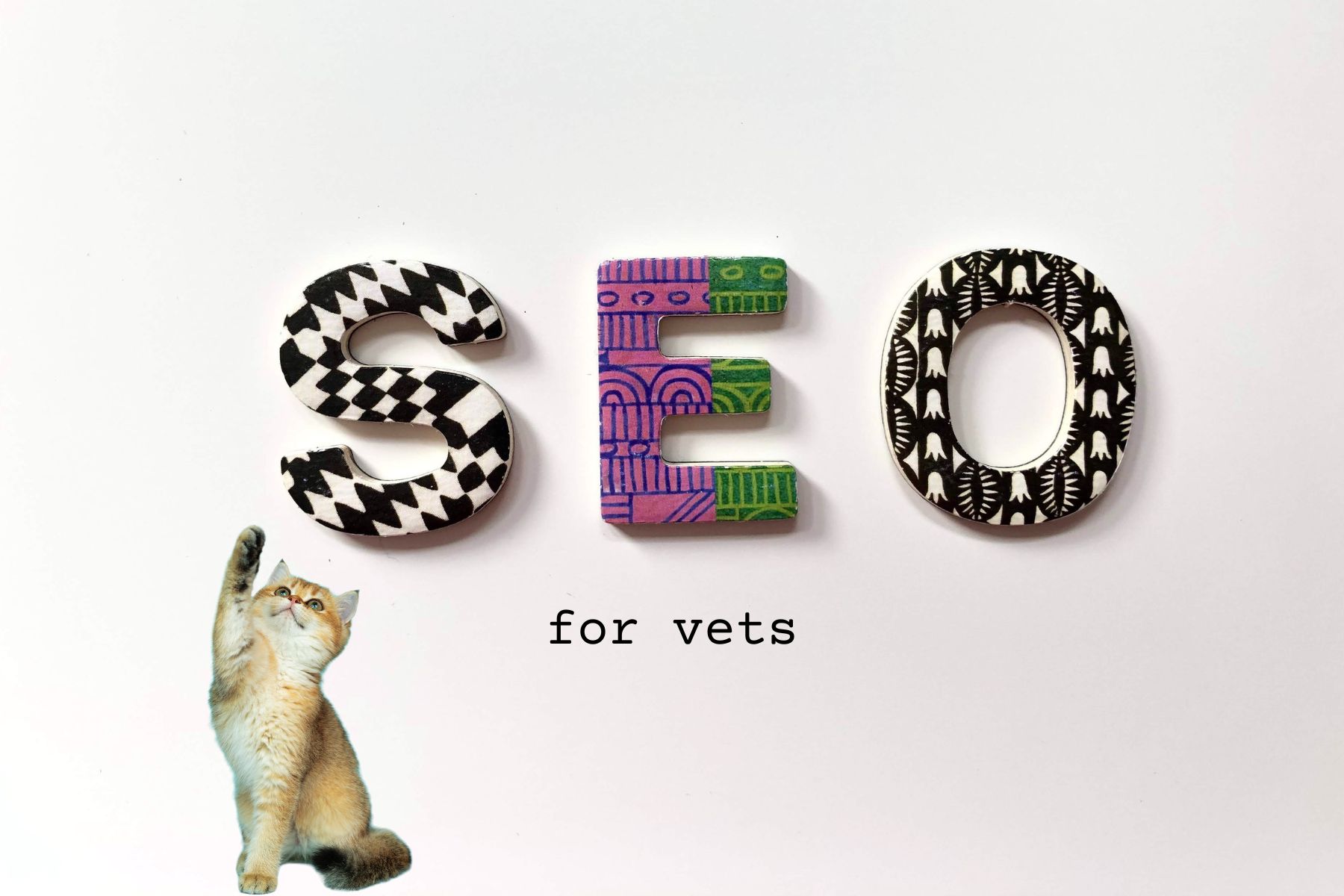Whether you’re a lone mobile vet, a locum vet, or you own a veterinary clinic, your position in search engine results will impact how people find you. Search Engine Optimisation (or SEO) is as essential for vets as it is for other businesses, but it’s not something you’ll have been taught at vet school! SEO for vets is something we’ve been working on for years, so we’re going to share some practical tips to help you get started. Even if you’ve just been left in charge of blog writing for your vet practice, knowing a little bit about SEO will help your clinic’s website stand out!
What is SEO for vets?
SEO means Search Engine Optimisation. It’s the practise of tweaking your website to perform well in search engine results. In order to gain new clients, your vet practice needs to be close to the top of the results page when someone searches for ‘vet practices in Liverpool’ or similar – SEO is the way to make that happen. If you’re a locum vet or vet personality, the principle is the same, but you’ll need to optimise for slightly different searches.
SEO is a whole industry – specialist ‘SEO expert’ marketers all claim to know Google’s ‘secret sauce’ to get you top results. But the truth is, nobody really knows what Google wants, and it changes all the time anyway. That’s not to say that these marketers aren’t useful (they can be!), but when you’re on a tight budget you might want to try some of these SEO tips yourself first, calling in a marketer to help you fine-tune at a later date.
The Principles of SEO for Vets
There are some main principles of SEO for vets you need to know in order to move yourself up those results pages. Lets quickly go over what these are, before we give you some actionable steps in the next section.
Keywords
When someone searches for something, what they type (or speak!) into the search bar is their ‘query’. The closer your website matches key words in that query, the higher up the results page you’ll be. Of course, it’s a little more complicated than that, but keywords are still the most important ranking factor. If you’re working on your vet practice website and thinking about SEO, you’ll need to do keyword research and use keywords on your website pages to help search engines show your results to related queries.
Linkedy Link Links
Another important ranking factor is hyperlinks – those into, within, and out of your website. Hyperlinks into your website from other websites show Google how authoritative you are on a subject, and are a good way to be seen as a leader in the area – great if you’re a vet personality positioning yourself as a thought leader. Hyperlinks leaving your website pass your trust and authority along with them, so take care who you link to.
But when it comes to SEO for vets, hyperlinking within your website is essential. You want to keep people (and Google bots) moving from page to page in your website, seamlessly. It helps you provide a great user experience (essential for SEO!) and answer people’s questions. It’s also how you move people along from simply visiting your website to booking an appointment or contacting you.
Use of images
Using images on your website is important for user experience, but don’t miss out on the data that goes with them. Every image can be assigned a filename and an Alt tag – both are pieces of information that Google can ‘read’ to see more about your website. Remember those keywords? They need to be used in your filenames and alt tags to help Google categorise your website and show it to relevant search queries.
Headings, subheadings, and other text metadata
Lastly we have metadata. This is the non-visible stuff that is on your website that Google can ‘read’. Your webpage title will have a H1 (1st header) title tag – Google assigns a lot of importance to this, obviously. But your H2 and H3 subheadings will also provide metadata to google that you should utilise. Optimising these ‘title tags’ is part of SEO.
Another common piece of metadata that can be optimised is your meta-description. This is the short piece of writing under the blue bit on a Google SERP page. Optimising this with keywords can help people find you – hurray!
E-E-A-T
We’re not going to go into detail about E-E-A-T here, as it’s not very relevant to your veterinary clinic pages. I’ve mentioned it only because you might see it mentioned elsewhere, but it’s not the most important thing for ranking business listings. If you have a practice blog, E-E-A-T might be relevant, but chances are that as a vet you’ll have most of the E-E-A-T bits down anyway! If you want to know more about E-E-A-T and E-A-T, we’ve linked our posts on them for you.
What can I do to help my vet practice SEO?
Right, we promised you some easy actionable tasks that you can undertake to help SEO for vets. So, here they are:
1. Start a blog
If you don’t yet have a vet practice blog, it’s time to start one. There are lots of reasons you need one, but one of their main benefits is that they provide Google with lots of keywords. Rather than your usual static webpages that don’t change much over time, your blog has loads of fresh content and gives a great place to use keywords you can’t squeeze in elsewhere. You can also use it for content marketing, which is great for SEO. It’s much easier to write a blog for a vet clinic than most people think, but don’t forget it’s also an easy service to outsource to a specialist content-writing agency!
2. Check your metadata
Go through each page of your website checking your metadata. You want to only have one H1 tag per page – so that’s the first thing to check. While this is amazing for keywords, you want to prioritise user experience so don’t change your H1 headers to include a keyword unless you’re missing an obvious one. Next, check your subheadings (H2 and H3 tags) found in the text of the page. These can be liberally sprinkled with keywords – but still prioritise user experience! Using a service like Yoast can make this easier for you by automating alerts when you have too many H1 tags on a page, or you haven’t used your keyword enough.
3. Check all your images on your website
Now, check that each image on your website contains metadata that includes your keywords. You can change the title of images in most website builders, but you might need to re-upload the image to change the filename. You can also fiddle with the Alt tag to include the image – although please remember that the alt tag is primarily there for text-to-speech services (i.e for access by the blind) so please remember this when using this function.
Bonus – Research your keywords
Ok, so that isn’t the easiest step in the world, which is why we didn’t include it in our three. But it does underpin pretty much all of the SEO you’ll do on your website! Don’t worry, I’ll walk you through it in more detail in our second SEO for vet practices post. We’re also writing an article all about veterinary keywords – we’ll link it here when we’re done. Essentially, you need to find out:
- What people who need your services are searching for
- What keywords you currently rank highly for
- What keywords you have on your website that you aren’t in the top 5 results for
- What keywords you’re missing out on
Conclusion – SEO for vets isn’t hard!
At the end of the day, SEO for vets isn’t too difficult, and most vet practices can positively impact their own SEO by making some minor changes without needing to call in experts. Hopefully the rest of our series on digital marketing for vets will also give you the confidence you need to help your website stand out from the rest.
-
Content Planning for your Vet Practice
Your digital content is an important part of the marketing strategy for your business but is also an online representation of your practice. If your content proves popular, it could… Read more
-
Running Great Vet Email Campaigns (Our Top Tips)
If you’re a vet practice manager, owner, or marketer, you might already be contacting clients by email, either with practice news, appointment reminders, or clinical information. But have you considered… Read more
-
Marketing for Veterinarians: Making a Marketing Plan
For some vets, marketing can feel like a challenge. With so many bits of jargon and different costs involved, it can be hard to know where to begin! The good… Read more
-
What makes ‘good’ vet blog content?
Many vet practices have an online blog now, it’s a great way of engaging with customers remotely. But how can you make sure yours stands out? With so many benefits of… Read more
-
3 veterinary blog post ideas for every month of the year
There are so many benefits of a vet practice blog but it can be hard to come up with inspiration for regular fresh content! If you’re not sure what your practice should… Read more


